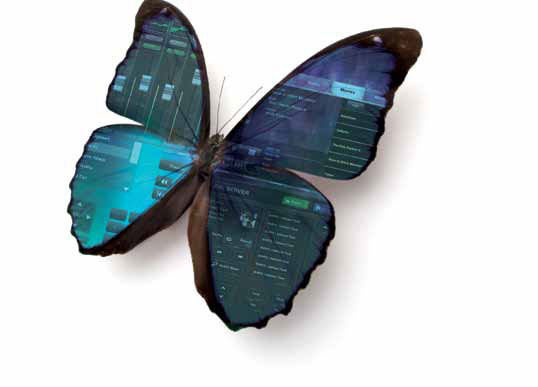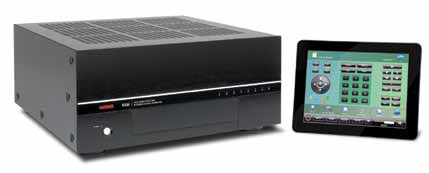Morphing Control

User Interfaces Take On New Shapes In The iPad Era
There’s little doubt that the proliferation of wireless handheld devices, including Apple’s iPhone and iPad, Android OS-based phones, and RIM’s BlackBerry, has had an impact on touchpanel developers. It’s something of a two-way street—not only have control system manufacturers started to make available various applications for third party wireless devices but the operational simplicity of the typical handheld is also affecting the way that interfaces are laid out and the way that users expect to interact with these apps.
Just a few months ago, Crestron Electronics found itself in the enviable position of having one of the top grossing apps in the world in the iTunes Store, and the only one in the industry to reach the top 100, with its Mobile Pro G iPad app. Developing apps for new mobile devices is just the latest step in a history of innovation for Crestron, according to the company’s public relations manager, Jeffrey Singer.
“The idea of wanting to be able to access and control rooms, devices, even entire buildings, from a central or remote location is not new,” he pointed out. “We were the first company to put an IP ethernet port on a control system. That was in 1998 with XPanel technology, emulating touchpanels on PCs and laptops. We also came out with mobile devices using Windows CE back then.” Crestron has, over the years, introduced software developer kits for a wide range of operating systems and other programs.

With Lectrosonics’ iPhone/iPad app for its Aspen Series, customization even extends to being able to modify the graphic display of the participants sitting around the conference table.
“It’s another way of accessing, controlling and managing,” he continued. “We take what often are highly sophisticated or complex technologies and make them very easy to use, understandable, and intuitive for the user.”
Perhaps most importantly, he said, “Our app, which is different from any other app, is totally customizable. You can select themes and colors, but we also give our installers the ability to customize the interface.” Corporations, agencies, and other businesses have brands, he noted, “and that brand can be brought into the control interface. So you get a consistent user experience across the board regardless of the interface that you’re using.”
A daily selection of the top stories for AV integrators, resellers and consultants. Sign up below.
At the InfoComm show earlier this year, Lectrosonics previewed a new iPhone/iPad app for its Aspen Series that offers customization, fully supports Crestron modules and is currently in beta for both AMX and Android. Using Command Fusion’s guiDesigner, the free app supports one portrait and one landscape mode but a small license fee unlocks as many subpages as desired.
“We’re trying to empower our users, saying, now you can create an interface, whatever you want, and brand it for your customers,” explained Frank Gonzales, control and applications engineer at Lectrosonics “What we’ve created is the back end that has all of the Aspen commands and all the feedback to update your buttons.”
The GUI is very intuitive, he continued: “If you want to change the gain of a particular speaker you touch the microphone and up comes the attenuation controls. If you want to make a phone call you just touch the telephone and up comes a keypad, and through the master Aspen system it automatically talks to the conferencing unit and takes care of all the communication.”
Customization even extends to being able to modify the graphic display of the participants sitting around the conference table, he added. “Since it’s all images controlled as subpages you can change the people out in the seats.”
AMX recognized the potential of handheld devices and partnered with Touch Panel Control to develop an iPhone app, said AMX chief technology officer Robert Noble. “It’s been fairly successful,” he revealed. Noble sees wireless handheld apps enabling tech support efficiencies in commercial situations: “There may be a pretty skinny crew to start with providing that service and they may be spread over a large building or a campus.”
He has also observed touchpanel integration with VoIP and SIP systems. “I can literally turn my touchpanel into a telephony device. That’s probably the biggest thing that is just now catching on,” he said.

Since AMX systems enable just about anything that can be imagined, he continued, the trick is to keep the interface simple. “Things like the Apple products, the Android pieces, have driven a different level of awareness. That’s getting leveraged quite a bit back into our industry.”
According to Ethan Wetzell, product manager Electro-Voice signal processing, Bosch Communications Systems, the company’s new TPI-12 (12-inch) and TPI-8 (8-inch) touchpanels were intended more to provide another option to E-V customers than to compete with AMX or Crestron solutions. “Not everybody is a Crestron dealer or programmer. When you’re working with a TPI-8 or -12 you write the interface in the exact same IRIS-Net file that you would use to create the basic DSP or PC configuration. This is something that the customer is already familiar with, can do themselves, and can create a more economic solution in some circumstances for that type of touchbased interface,” Wetzell elaborated.
As for extending control and management to third party mobile devices, “We don’t have anything to announce at this time,” he said carefully. Currently the company’s DSP products are fully addressable by openly published parser code, he noted.
Wetzell also stressed the advantage of careful GUI design: “There’s an art and science to designing a useful GUI and HMI for the user to interact with. How do you display and express intent; how do you make it very clear and obvious as to what button does what; how do you use color and object positioning on the screen to draw somebody’s attention to it? What are the ways that you can make that system simple and easy to use?”
The proliferation of mobile devices “is helping people become more savvy about designing touch-based interfaces,” Wetzell believed. “They know what they interact with, what works and what doesn’t.”And since non-technical people are typically using these touchpanel devices, he observed, “The user doesn’t need to be aware of what’s going on behind the scenes. They just need to be aware of the end result.”
Steve Harvey (psnpost@nbmedia.com) has been west coast editor for Pro Sound News since 2000 and also contributes to TV Technology and Pro Audio Review.
